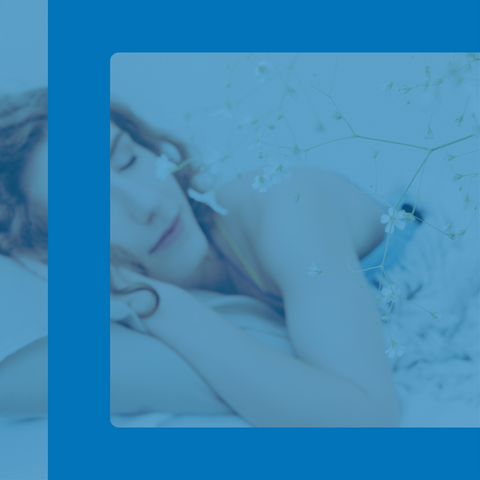
Sleep is an extremely important component of physical and emotional health and well-being. If you’re curious as to why sleep is such a necessity, check out this previous article.
The lack of or disruption of sleep, a phenomenon called insomnia, is prevalent across nations [1]. Insomnia is one of eight sleep challenges we have previously discussed. The general consensus from population-based studies is that 30% of adults experience one or more of the symptoms of insomnia, which include difficulty getting to sleep or staying asleep, waking too early, and poor sleep quality [2].
There has been an increase in the prevalence of insomnia since the COVID-19 pandemic [3]. Unfortunately, insomniacs rarely discuss their symptoms with a physician, and 4 out of 10 insomniacs self-medicate with over-the-counter drugs or alcohol [2].
For centuries, herbal treatments have been popular for their safety and effectiveness. Thus, in today’s article, we are going to investigate some of the most common herbal remedies for sleep and explain how they work.
Valerian Root
Found in Europe and parts of Asia, valerian (Valeriana officinalis) has a long history of being used as a sedative. In fact, recorded medicinal use of valerian dates back to the first century AD [4]. In vitro and clinical studies have demonstrated reduced sleep latency and improved subjective measures of sleep [5-7].The mechanisms of action of valerian likely involve serotonergic and GABAergic signaling pathways [6] as well as adenosine [4]. If you’d like to learn more about the effect of sleep hormones in the GABA system, read here!
Recent meta-analysis evidence found no serious adverse effects with valerian intake in people within 7 and 80 years of age [4]. Despite this, valerian should not be used in combination with other nervous system depressants such as alcohol, barbiturates, benzodiazepines, opiates, kava, or antihistamines [8].
Passion Flower
Native to the southern United States, passion flower (Passiflora incarnata) has historical use as a herbal sedative, anxiolytic, and popular sleep aid [9,10].
Rodent studies have shown that passion flower extract increased total sleep time (specifically slow wave sleep patterns) and decreased wakefulness, as well as reduced rapid eye movement sleep [9].
Human studies have shown that a herbal tea made from passion flower consumed daily over the span of a week notably improved sleep quality in comparison with a placebo beverage [10]. Two weeks of passion flower consumption also improved total sleep time as well as sleep efficiency and wake after sleep onset time [11].
Lemon Balm
Lemon balm (Melissa officinalis) is part of the mint family and native to Europe, Asia, and Iran but has been naturalized elsewhere.
Although only few studies have shown the beneficial effects of lemon balm on sleep by itself, it can be very helpful when combined with other calming herbs (such as valerian above) [12]. One of the few studies in humans showed that 8 weeks of supplementation with 3 g of lemon balm alone decreased depression, anxiety, stress, and sleep disorders in patients with chronic stable angina [13].
Chamomile
Chamomile (Matricaria chamomilla) is one of the most ancient medicinal herbs known to man, represented by two common varieties (German and Roman) [14,15]. It has been used since antiquity to treat human ailments such as hay fever, inflammation, muscle spasms, insomnia, menstrual disorders, ulcers, wounds, gastrointestinal problems, rheumatic pain, and hemorrhoids [14,16].
Worldwide, over one million cups of herbal tea made from chamomile is consumed per day, demonstrating its immense popularity.
Chamomile has a reputation as a calming preparation and sleep inducer, likely due to the effects of the flavonoid apigenin that binds to benzodiazepine receptors in the brain. As such, chamomile can significantly improve sleep quality and improve generalized anxiety disorder after 2 and 4 weeks of administration, with only three studies reporting mild adverse events [17].
Lavender
In different traditional medicines, lavender (Lavandula) has been called “the broom of the brain” [18] and is one of the most used plants for patients with sleep disorders. It is most popularly used via inhalation of its essential oil alone, or in combination with massage.
Lavender has purported many therapeutic and curative properties ranging from inducing relaxation to addressing insect bites, burns, parasitic infections, and spasms [19]. It is geographically prevalent and includes more than 30 species, dozens of subspecies, and hundreds of hybrids and selected cultivars.
Lavender essential oil has been associated with improved sleep quality in people without insomnia in a recent systematic review [20]. In palliative care, lavender has shown beneficial effects on sleep quality [21].
California Poppy
The California poppy (Eschscholzia californica) is the iconic flower of said state, with native ranges from Northern California to Southwest Mexico. It was highly prized by Native Americans for its medicinal value, due to various metabolites such as benzylisoquinoline alkaloids [22].
It has a variety of natural compounds that possess sedative, anxiolytic, and analgesic effects [23,24]. In vitro research has suggested that the alkaloids it contains might improve sleep latency and duration primarily via GABA and serotonin receptors [23]. A rodent study from the early 1990s showed the beneficial effects of California poppy extract on sleep induction without any toxic effects [25]. To learn more about GABA and serotonin, read here and here for our in-depth guides!
Summary
Here, we have presented several types of herbal sleep remedies that offer benefits for sleep promotion and quality in humans. With appropriate supervision from a physician, if necessary, these remedies can be used to help combat insomnia and support more restful and rejuvenating sleep.
Aside from herbal sleep remedies, you can also check out Tro Zzz, our complete sleep solution troche that helps you fall asleep, stay asleep, and waking up feeling refreshed!
References
[1] T. Roth, Insomnia: definition, prevalence, etiology, and consequences, J Clin Sleep Med. 3 (2007) S7-10.
[2] S. Ancoli-Israel, T. Roth, Characteristics of insomnia in the United States: results of the 1991 National Sleep Foundation Survey. I, Sleep. 22 Suppl 2 (1999) S347-353.
[3] C.M. Morin, L.-A. Vézina-Im, H. Ivers, J.-A. Micoulaud-Franchi, P. Philip, M. Lamy, J. Savard, Prevalent, incident, and persistent insomnia in a population-based cohort tested before (2018) and during the first-wave of COVID-19 pandemic (2020), Sleep. 45 (2022) zsab258. https://doi.org/10.1093/sleep/zsab258.
[4] N. Shinjyo, G. Waddell, J. Green, Valerian Root in Treating Sleep Problems and Associated Disorders-A Systematic Review and Meta-Analysis, J Evid Based Integr Med. 25 (2020) 2515690X20967323. https://doi.org/10.1177/2515690X20967323.
[5] D. Benke, A. Barberis, S. Kopp, K.-H. Altmann, M. Schubiger, K.E. Vogt, U. Rudolph, H. Möhler, GABA A receptors as in vivo substrate for the anxiolytic action of valerenic acid, a major constituent of valerian root extracts, Neuropharmacology. 56 (2009) 174–181. https://doi.org/10.1016/j.neuropharm.2008.06.013.
[6] B.M. Dietz, G.B. Mahady, G.F. Pauli, N.R. Farnsworth, Valerian extract and valerenic acid are partial agonists of the 5-HT5a receptor in vitro, Brain Res Mol Brain Res. 138 (2005) 191–197. https://doi.org/10.1016/j.molbrainres.2005.04.009.
[7] C.M. Morin, U. Koetter, C. Bastien, J.C. Ware, V. Wooten, Valerian-hops combination and diphenhydramine for treating insomnia: a randomized placebo-controlled clinical trial, Sleep. 28 (2005) 1465–1471. https://doi.org/10.1093/sleep/28.11.1465.
[8] T.B. Klepser, M.E. Klepser, Unsafe and potentially safe herbal therapies, Am J Health Syst Pharm. 56 (1999) 125–138; quiz 139–141. https://doi.org/10.1093/ajhp/56.2.125.
[9] F.A. Guerrero, G.M. Medina, Effect of a medicinal plant (Passiflora incarnata L) on sleep, Sleep Sci. 10 (2017) 96–100. https://doi.org/10.5935/1984-0063.20170018.
[10] A. Ngan, R. Conduit, A double-blind, placebo-controlled investigation of the effects of Passiflora incarnata (passionflower) herbal tea on subjective sleep quality, Phytother Res. 25 (2011) 1153–1159. https://doi.org/10.1002/ptr.3400.
[11] J. Lee, H.-Y. Jung, S.I. Lee, J.H. Choi, S.-G. Kim, Effects of Passiflora incarnata Linnaeus on polysomnographic sleep parameters in subjects with insomnia disorder: a double-blind randomized placebo-controlled study, Int Clin Psychopharmacol. 35 (2020) 29–35. https://doi.org/10.1097/YIC.0000000000000291.
[12] S. Taavoni, N. Nazem Ekbatani, H. Haghani, Valerian/lemon balm use for sleep disorders during menopause, Complement Ther Clin Pract. 19 (2013) 193–196. https://doi.org/10.1016/j.ctcp.2013.07.002.
[13] H. Haybar, A.Z. Javid, M.H. Haghighizadeh, E. Valizadeh, S.M. Mohaghegh, A. Mohammadzadeh, The effects of Melissa officinalis supplementation on depression, anxiety, stress, and sleep disorder in patients with chronic stable angina, Clin Nutr ESPEN. 26 (2018) 47–52. https://doi.org/10.1016/j.clnesp.2018.04.015.
[14] J.K. Srivastava, E. Shankar, S. Gupta, Chamomile: A herbal medicine of the past with bright future, Mol Med Rep. 3 (2010) 895–901. https://doi.org/10.3892/mmr.2010.377.
[15] T.M. Osaili, D.K. Dhanasekaran, F. Zeb, M.E. Faris, F. Naja, H. Radwan, L. Cheikh Ismail, H. Hasan, M. Hashim, R.S. Obaid, A Status Review on Health-Promoting Properties and Global Regulation of Essential Oils, Molecules. 28 (2023) 1809. https://doi.org/10.3390/molecules28041809.
[16] H.B. Forster, H. Niklas, S. Lutz, Antispasmodic effects of some medicinal plants, Planta Med. 40 (1980) 309–319. https://doi.org/10.1055/s-2008-1074977.
[17] T.H. Hieu, M. Dibas, K.A. Surya Dila, N.A. Sherif, M.U. Hashmi, M. Mahmoud, N.T.T. Trang, L. Abdullah, T.L.B. Nghia, M.N. Y, K. Hirayama, N.T. Huy, Therapeutic efficacy and safety of chamomile for state anxiety, generalized anxiety disorder, insomnia, and sleep quality: A systematic review and meta-analysis of randomized trials and quasi-randomized trials, Phytother Res. 33 (2019) 1604–1615. https://doi.org/10.1002/ptr.6349.
[18] J. Luo, W. Jiang, A critical review on clinical evidence of the efficacy of lavender in sleep disorders, Phytother Res. 36 (2022) 2342–2351. https://doi.org/10.1002/ptr.7448.
[19] P.H. Koulivand, M. Khaleghi Ghadiri, A. Gorji, Lavender and the nervous system, Evid Based Complement Alternat Med. 2013 (2013) 681304. https://doi.org/10.1155/2013/681304.
[20] T.-Y. Chen, A. Hiyama, M. Muramatsu, A. Hinotsu, The Effect of Lavender on Sleep Quality in Individuals Without Insomnia: A Systematic Review, Holist Nurs Pract. 36 (2022) 223–231. https://doi.org/10.1097/HNP.0000000000000528.
[21] D. Yıldırım, V. Kocatepe, G. Can, E. Sulu, H. Akış, G. Şahin, E. Aktay, The Effect of Lavender Oil on Sleep Quality and Vital Signs in Palliative Care: A Randomized Clinical Trial, Complement Med Res. 27 (2020) 328–335. https://doi.org/10.1159/000507319.
[22] A. Becker, Y. Yamada, F. Sato, California poppy (Eschscholzia californica), the Papaveraceae golden girl model organism for evodevo and specialized metabolism, Front Plant Sci. 14 (2023) 1084358. https://doi.org/10.3389/fpls.2023.1084358.
[23] M. Fedurco, J. Gregorová, K. Šebrlová, J. Kantorová, O. Peš, R. Baur, E. Sigel, E. Táborská, Modulatory Effects of Eschscholzia californica Alkaloids on Recombinant GABAA Receptors, Biochem Res Int. 2015 (2015) 617620. https://doi.org/10.1155/2015/617620.
[24] A. Rolland, J. Fleurentin, M.C. Lanhers, R. Misslin, F. Mortier, Neurophysiological effects of an extract of Eschscholzia californica Cham. (Papaveraceae), Phytother Res. 15 (2001) 377–381. https://doi.org/10.1002/ptr.884.
[25] A. Rolland, J. Fleurentin, M.C. Lanhers, C. Younos, R. Misslin, F. Mortier, J.M. Pelt, Behavioural effects of the American traditional plant Eschscholzia californica: sedative and anxiolytic properties, Planta Med. 57 (1991) 212–216. https://doi.org/10.1055/s-2006-960076.





Comments (0)
There are no comments for this article. Be the first one to leave a message!